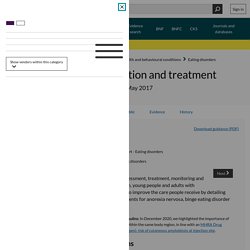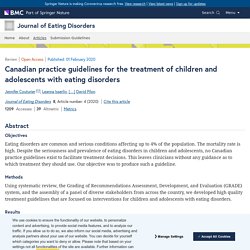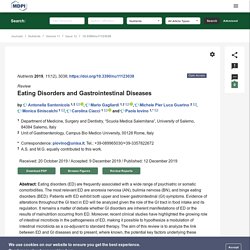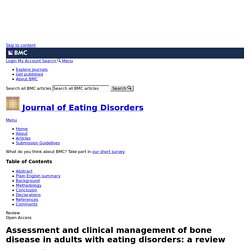

Eating disorders: recognition and treatment. This guideline covers assessment, treatment, monitoring and inpatient care for children, young people and adults with eating disorders.

It aims to improve the care people receive by detailing the most effective treatments for anorexia nervosa, binge eating disorder and bulimia nervosa. MHRA safety update on insulins: In December 2020, we highlighted the importance of rotating insulin injection sites within the same body region, in line with an MHRA Drug Safety Update on insulins (all types): risk of cutaneous amyloidosis at injection site. Recommendations This guideline includes recommendations on:
Predicting eating disorders from Internet activity - Sadeh‐Sharvit - 2020 - International Journal of Eating Disorders. Athlete-Specific Treatment for Eating Disorders: Initial Findings from the Walden GOALS Program - Journal of the Academy of Nutrition and Dietetics. Canadian practice guidelines for the treatment of children and adolescents with eating disorders. Family therapy Three thousand, five hundred and twenty-two abstracts were identified for review within the family therapy section of our guideline (see PRISMA flow diagram, Fig. 1).

Nineteen additional abstracts were identified through citation chaining (up to November 23, 2018) and review of reference lists. Two additional papers were identified through external review. After duplicates were removed, abstracts screened, and full text articles reviewed, 74 studies were included within the family therapy section of our guideline. PRISMA flow diagram for family therapy. Eating Disorders and Gastrointestinal Diseases. 1.

Eating Disorders Eating disorders (ED) are a crucial health problem in Western countries and mainly in the young population [1]. ED are very complex, lacking a pathophysiological definition, and are clinically recognized by strict diagnostic criteria of the Fifth Edition of the Diagnostic and Statistical Manual of Mental Disorders (DSM-V), released by the American Psychiatric Association [2]. Anorexia nervosa (AN), Bulimia nervosa (BN) and Binge Eating Disorder (BED) are the three major categories of ED (Figure 1).
Figure 1. ED can be associated with anxiety or mood disorders; insomnia; as well as somatic complications such as cardiac alterations, hormonal imbalances and also a wide range of gastrointestinal (GI) symptoms [3]. Prevalence estimate of lifetime AN is 0.8% [4]. The prevalence of BN is 0.28% [4]. BED co-occurs with a variety of psychiatric disorders, especially mood (54.2%), anxiety (37.1%) and substance use disorders (24.8%) [16]. Anorexia and the Gut Microbiome - Today's Dietitian Magazine. October 2019 Issue Anorexia and the Gut Microbiome — Looking Beyond the Debate Over Genetics vs Environment By Carrie Dennett, MPH, RDN, CD Today’s Dietitian Vol. 21, No. 10, P. 28 Anorexia nervosa (AN)—an eating disorder characterized by extreme weight loss or failure to gain expected weight accompanied by fear of weight gain—has the highest mortality rate of any psychiatric illness, and only one-half of patients experience long-term recovery.1,2 Patients with AN often experience other psychological and physiological disturbances, including anxiety, depression, and gastrointestinal (GI) distress, further complicating treatment.3-5 The Academy for Eating Disorders recently published “Nine Truths About Eating Disorders.”

“Multiple disease processes result in the symptom cluster we call anorexia nervosa,” says Jessica Setnick, MS, RD, CEDRD-S, Dallas-based author of The Eating Disorders Clinical Pocket Guide and owner of www.UnderstandingNutrition.com. The Chicken or the Egg? References 1. Treatment of Anorexia Nervosa—New Evidence-Based Guidelines. 3.2.1.

Treatment Setting For adults: Similar to the German guideline [14], all remaining guidelines (excluding the Danish [40] and WFSBP guidelines [47]) recommend outpatient treatment as a first treatment option, suggesting day patient or inpatient treatment as a more intensive treatment option if outpatient treatment proves ineffective [38,39,41,43,44,46,48]. The German guideline states, however, that in some cases this ‘stepped-care’ approach may not be appropriate. Inpatient treatment is recommended in cases with a BMI <15 kg/m², rapid or continuing weight loss (>20% over 6 months), high physical risk, severe co-morbid conditions or denial of illness. If these criteria are met, an inpatient setting may be necessary for initial treatment. 3.2.2.
For adults: All guidelines except for the Danish [40] and WFSBP [47] address the efficacy of specific psychological interventions. Some guidelines make recommendations regarding the required duration of treatment. Table 2. 3.2.3. 3.2.4. Assessment and clinical management of bone disease in adults with eating disorders: a review. Studies published in the English language between 1996 and 2016 were searched in PubMed.

We used keywords for the search including “anorexia nervosa” and “bone density” and then manually selected relevant papers based on the number of included subjects, journal impact factor and participant age range. Treatment-specific articles for this patient population were searched using additional keywords such as “premenopausal” and “treatment” and randomized controlled trials were favored for review. Several articles were referenced prior to 1996 that provided essential baseline data for this population that were not found in the abovementioned search criteria. Definition.
Clinical Applications of Orthorexia Nervosa (Part 3 of 3) – RDLounge.com. This blog wraps up a three-part series on orthorexia nervosa (ON).

If you haven’t already, be sure to read Part 1 and Part 2, in which I provide historical context, recommended diagnostic criteria, and state of the research related to ON. This final blog post will focus on clinical strategies for screening and treating ON. Screening for ONWhile health care providers still are awaiting official diagnostic criteria, it’s possible to screen for an unhealthy obsession with nutrition and health in your practice. Keep the proposed diagnostic criteria close by, and, if you suspect someone is at risk, consider asking some of the following questions: Are you spending more time thinking about your food choices than you wish you were?
Treatment StrategiesTreating ON is quite similar to treating other eating disorders in that the food and exercise rules and rituals are rooted in anxiety management and overly correlated with a person’s self-esteem or feelings of self-worth. Like this: Like Loading... Eating disorders: recognition and treatment. הטיפול בהפרעות אכילה בישראל מאי 2017. Preventing Obesity and Eating Disorders in Adolescents.
Inter-Association Recommendations for Developing a Plan to Recognize and Refer Student-Athletes With Psychological Concerns at the Collegiate Level: An Executive Summary of a Consensus Statement. Royal Australian and New Zealand College of Psychiatrists clinical practice guidelines for the treatment of eating disorders. Medical stabilisation Admission to hospital is indicated if the person is at imminent risk of serious medical complications, or if outpatient treatment is not working (Beumont et al., 2003).

Indicators of high medical risk requiring consideration for admission (see Table 3) include any one of the following: heart rate <40 bpm or tachycardia on standing due to cardiac deconditioning with >20 bpm increase in heart rate, blood pressure <90/60 mm Hg or with >20 mm Hg drop on standing, hypokalaemia, hypoglycaemia, hypophosphataemia, temperature <35.5°C, or BMI < 14 kg/m2. It is important to note that patients can report feeling well even when the risk of cardiac arrest is high.